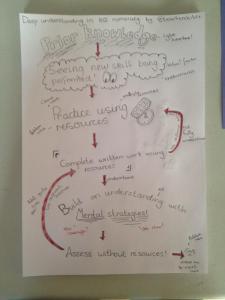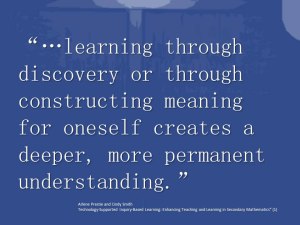Planning 1 more and 1 less for my Year 1 class last week and decided to plan using this model that I made during my PGCE.
This is how I used this model with my planning, just a brief outline as an example. With the curriculum focusing on mastery and the widening of understanding it is important to build a good base knowledge on which to build and expand.
One more and One less using the ‘deeper thinking model’
1. Prior Knowledge
– Test the children’s prior knowledge of the terms, vocab and basics by approaching the subject from a different angle.
I removed the concept from numeracy and brought in ‘The Gruffalo’ by Julia Donaldson. I created a beautiful power point and told the story of the Gruffalo going for a picnic. Then one Gruffalo left the picnic. The children were then introduced to key vocab and questions. ‘Now we started with ten Gruffalo, (Plural for Gruffalo?) one has gone home. Do we have more Gruffalo or less Gruffalo?
After this we started to embed the concept of less and more using sweets. Whilst targeting SEN we conducted a practical session where I gave the children an amount of sweets, then adding and taking them away to set the idea of MORE and LESS in concrete.
We constantly counted backwards and forwards all week to cement knowledge of where numbers belong.
2. Seeing the new skill in action
We then gave the children simple verbal questions and let them choose what resource they liked to use. They chose Numicon, number lines and hundred squares. We had used the hundred squares a lot so we proceeded to use them the most.
We worked through these problems together, with me (the teacher) taking control and crushing misconceptions. At this point I am still using key language and phrases constantly, i.e. if we have more we know it will be a bigger number.
We then moved onto some simple problems using a number line on the IWB. (simple bunny hops)
3. Practice using resources
Given numbers they were very comfortable with and asked the solve them using resources, jotting down answers and working down on whiteboards.
This might be done in group work.
4. Written answers using resources
Children are given differentiated questions and asked ‘old school like’ to solve them using these resources. I tend to like this section to be independent work.
Teachers assesses and revisits with struggling children at this point.
5. Develop mental strategies.
We looked at the tens and unit when changing a number by 1 more or 1 less and noticed…
… what changed and that it was just like counting backwards and forwards.
We then practiced this in partner work and with the TA deployed to LA children.
6. Written work using mental strategies.
We then recapped on the mental strategies we developed. Following this the children were set questions were they were only allowed to use resources if they were really struggling. (putting a red dot next to a question they used resources on).
Teacher can then revisit strategies with and without resources depending on children’s understanding.
Some people may disagree with this model, however I thoroughly enjoyed teaching this week, and more importantly the children really enjoyed it. Only 1 from 30 didn’t get at least 80% of the questions right at the end of the week. Seems to work for my class and is helping them to solidify those crucial number facts



Reblogged this on Aspirational Inspirer and commented:
I really love the use of a flow chart to help planning
LikeLiked by 1 person